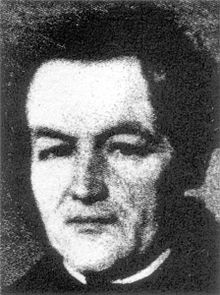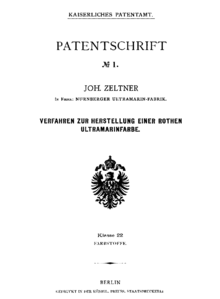Johannes Zeltner
Johannes Zeltner (born April 12, 1805 in Eschenbach ; † June 1, 1882 in Nuremberg ) was an honorary citizen of Wittenberg , manufacturer and entrepreneur in Nuremberg.
Life
Johannes Zeltner was a son of the hop trader and farmer Johann Zeltner. After attending school in Hersbruck , he joined his father's hops business in 1823. He began his independent entrepreneurial commitment in Nuremberg in 1830 with the opening of a hop and wine trade. In the same year he married his first wife Johanna Sybilla Amberger (* 1802). On his honeymoon he visited the city of Wittenberg and moved into the hotel "Goldene Weintraube". During his stay, his wife fell ill and died on September 13, 1830 at the age of 28. The corpse was transferred to Nuremberg in the double coffin and buried there. Zeltner was very affected by this stroke of fate and deposited a capital of 350 Reichstalers with Diakonus Seiler, which at that time represented the value of 1000 gold marks. From the interest, three confirmation women from Wittenberg, who were poor and worthy, were to receive confirmation clothes. In 1847 he received the honorary citizenship of the city of Wittenberg as a thank you for his foundation . In March 1874, Zeltner came again to Wittenberg and increased the capital of his foundation by 900 Reichstaler. His legacy donated a further 1,000 gold marks to the foundation in the city of Wittenberg. In 1833 he married again, this time Johanna Maria Katharina Scharrer (1815–57), the daughter of Johannes Scharrer .
Entrepreneur

In 1836 Zeltner supported his brother Johann Georg Zeltner (1807–86) in founding the Zeltner Brewery in Nuremberg. To do this, he acquired the Keppendörfsche Brewery in Schlotfegergasse. In the same year, out of entrepreneurial interests, he began to promote the process for the production of ultramarine developed by Thomas Leykauf (1815–1871) and Friedrich Wilhelm Heyne (1804–85) . In 1838 he built the first ultramarine factory in Bavaria on what is now Zeltnerstrasse. In 1859 he acquired the worsted spinning mill in Nuremberg, thereby ensuring its continued existence. In 1840 he took a share in the Hüttensteinacher Eisenwerkgesellschaft in Nuremberg and in 1852 took over the hook factory Oertle & Hertlein.
Despite his entrepreneurial commitment, Zeltner proved his open-mindedness towards the social concerns of his employees with the establishment and financial foundation of a health and funeral fund in 1839. He donated considerable sums for churches and social institutions, for example for the hostel to Heimat , Nadlersgasse 10 (today: Dr.-Kurt-Schumacher-Straße) which he founded in 1872 for poor craftsmen.
His commitment in the political and cultural area was evident as a member of the parish college from 1845–1848. As a liberal, he represented the constituency of Fürth in the Paulskirche parliament from December 11, 1848 to May 24, 1849 . In 1846 he became a member of the Chamber of Commerce in Nuremberg, its second director in 1836 and was the first director of the Nuremberg Industrial and Cultural Association from 1851 to 1855 . In 1858 he became director of the stock corporation in support of the Germanisches Nationalmuseum and since 1872 he sat on its administrative board. In 1859 he joined the Nuremberg Freemason Lodge To the three arrows in the Orient Nuremberg.
Tent lock
In 1845 he acquired the manor house at Gleißhammerstrasse 4, which had been damaged by a flood, and converted it. In Zeltner's honor, it was given the name Zeltner Castle . In 1920 the Reichsbahn acquired the seat, which was built in 1569 and burned out in 1943. The castle, which was rebuilt in 1955, has been owned by the city of Nuremberg since 1981, which set up a culture shop in it. Today the castle, located on an island, is one of the most attractive mansions in Nuremberg.
In 1866, Zeltner became the owner of the Obersteinbach manor in the Neustadt / Aisch district.
As a typical entrepreneur of the 19th century, Zeltner is one of the top representatives of Nuremberg's industry. He was honored by naming the street in Tafelhof.
First German imperial patent
On July 1, 1877, the first Reich Patent Act came into force after important German inventions had increasingly been registered abroad. On July 1, the patent submitted by Johannes Zeltner for a “process for the production of a red ultramarine color” with the number DRP 1 was registered. The patent was granted to him on November 27, 1877, the filing date was July 2.
Cultural
- On November 18, 1859 he became member number 509 of the Pegnese Flower Order
See also
- Villa Zeltnerheim
- History of the city of Nuremberg
- Castles, palaces and mansions in the city of Nuremberg
Literature and Sources
- "New German Bibliography" Volume 22, Page 583
- Martina Bauernfeind: Zeltner, Johannes . In: Michael Diefenbacher , Rudolf Endres (Hrsg.): Stadtlexikon Nürnberg . 2nd, improved edition. W. Tümmels Verlag, Nuremberg 2000, ISBN 3-921590-69-8 , p. 1209 ( online ).
- Communications from the Association for the History of the City of Nuremberg (MGVN) Volume 58, 1971, page 337 by H. Beckh
- Contribution to the Mitteldeutsche Zeitung from October 30, 1993 honorary citizen Wittenberg by Rudi Lipinski
- "Calendarium Historicum Vitebergense" by Max Senf (senior) Wittenberg 1912
Web links
- Ultramarine - the first German patent
- History of the Zeltner Castle ( Memento from December 18, 2007 in the Internet Archive )
Individual evidence
- ↑ Short story of the Zeltner Brewery ( memento of the original from April 25, 2016 in the Internet Archive ) Info: The archive link was inserted automatically and has not yet been checked. Please check the original and archive link according to the instructions and then remove this notice.
- ↑ History of the Obersteinbach Manor ( Memento of the original from March 4, 2016 in the Internet Archive ) Info: The archive link was inserted automatically and has not yet been checked. Please check the original and archive link according to the instructions and then remove this notice. (PDF file; 33 kB)
- ↑ Historical patents
| personal data | |
|---|---|
| SURNAME | Zeltner, Johannes |
| BRIEF DESCRIPTION | German manufacturer and entrepreneur, honorary citizen in Wittenberg |
| DATE OF BIRTH | April 12, 1805 |
| PLACE OF BIRTH | Eschenbach |
| DATE OF DEATH | June 1, 1882 |
| Place of death | Nuremberg |


